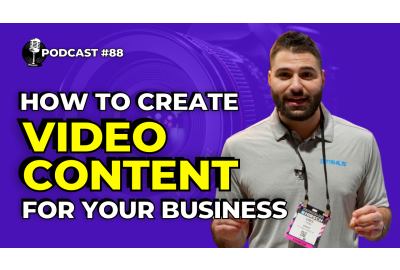Video Creation Tips for Business Owners
Season 13 of The Garment Decorators Podcast is kicking off with our very own Vince Fiore from the US team!
In this episode, we're diving into the world of video creation with expert, Vince Fiore from Stahls'. Talking about the best method to get started in video creation and why it's vital for your business in 2024.
Whether you're a solo entrepreneur or leading a team, mastering the art of video is vital. From elevating your marketing strategy, engaging your audience, and driving your business forward.
This episode covers:
- The Basics of Video Creation. What equipment do you need to get started? From cameras and microphones to editing tools and software, we've got it all covered.
- Content Planning & Strategy. How to plan your video content to align with your business goals. Ensuring each video delivers value and engages your target audience.
- Production Tips & Tricks. How to set up your shoot, capture the footage you need, and get the best results.
- Marketing & Distribution. Which video type is best for which platform? Find out how best to create and share videos that suit each platform appropriately. Whether you're starting out or looking to refine your video production skills. This episode is packed full of actionable advice. Helping you get started creating compelling videos for your business. It's time to take the first step towards becoming a video creation pro!
One particularly interesting part of this podcast is Vince's reasoning behind working hard to set himself apart from other content creators.
As with most long-form content creators, the dream of producing that content started at a young age. For Vince, his career has blossomed in a world of rapidly evolving technology where every digital device adds another level of competition to his role. He explains that the question with content creation is not just how do you create engaging content for your business?, but how do you set yourself apart from everyone else with an iPhone? Or in our audience's case, how do you set yourself apart from your competition?
The rapidly evolving world of consumer cameras and smartphones has made high-quality technology significantly more accessible and user-friendly and you should be utilising these advantages to give your business a web presence.
Checkout Vince's tips for getting started in the full podcast below:
If you enjoyed this episode, check out our other podcast episodes on Youtube, Spotify, Apple Music and Instagram.
When it comes to videography, both iPhones and traditional cameras have their unique advantages and limitations.
Here's a comparison to help you understand the differences and make an informed decision for your business:
1. Portability and Convenience
iPhone: Extremely portable, fits in your pocket, and is always with you. Its ease of use and instant accessibility make it ideal for spontaneous shooting.
Traditional Camera: Generally bulkier and requires carrying additional lenses, batteries, and accessories. Less convenient for quick, on-the-go shooting.
2. Image Quality
iPhone: Modern iPhones offer impressive video quality with high resolutions (4K), good low-light performance, and advanced stabilization. The latest models have multiple lenses and advanced software processing.
Traditional Camera: Higher-end DSLRs and mirrorless cameras typically offer superior image quality, especially in terms of sensor size, dynamic range, and depth of field. They also have better performance in low-light conditions.
3. Ease of Use
iPhone: User-friendly interface with intuitive controls and automatic settings. Advanced features like Smart HDR, Cinematic mode, and stabilization are designed to simplify the filming process.
Traditional Camera: May have a steeper learning curve with manual settings for exposure, focus, and white balance. However, this also allows for greater creative control.
4. Audio Quality
iPhone: Built-in microphones are decent for casual shooting, but they may not capture high-quality audio in noisy environments. External microphones can be attached via the Lightning port.
Traditional Camera: Typically offers better audio inputs with options for external microphones and audio recording equipment, which can significantly enhance sound quality.
5. Editing and Sharing
iPhone: Directly integrates with editing apps like iMovie, Final Cut Pro, or third-party apps like LumaFusion. Sharing to social media is seamless and quick.
Traditional Camera: Requires transferring footage to a computer for editing, often using software like Adobe Premiere Pro, Final Cut Pro, or DaVinci Resolve. The process can be more time-consuming but allows for more detailed editing.
6. Durability and Battery Life
iPhone: Battery life is generally good but can be limited for long shooting sessions. Protection against elements like dust and water varies by model.
Traditional Camera: Usually has better battery life for extended shooting and can be more rugged, especially in weather-sealed models designed for professional use.
7. Creative Flexibility
iPhone: Limited by the built-in lens options and lack of manual controls compared to professional cameras. However, software advancements and accessories are constantly bridging this gap.
Traditional Camera: Offers a wide range of lenses, filters, and accessories, along with manual controls, allowing for more creative possibilities and experimentation with depth of field, focal length, and exposure settings.
Conclusion:
For Casual or Social Media Content: iPhones are excellent due to their convenience, quality, and ease of use.
For Professional or High-Quality Production: Traditional cameras are typically the better choice due to their superior image quality, control, and versatility.
Ultimately, the best choice depends on your specific needs, the type of content you’re creating, and your comfort with the equipment. Many professionals also use iPhones as a supplementary tool for their work, leveraging its portability and advanced features.

